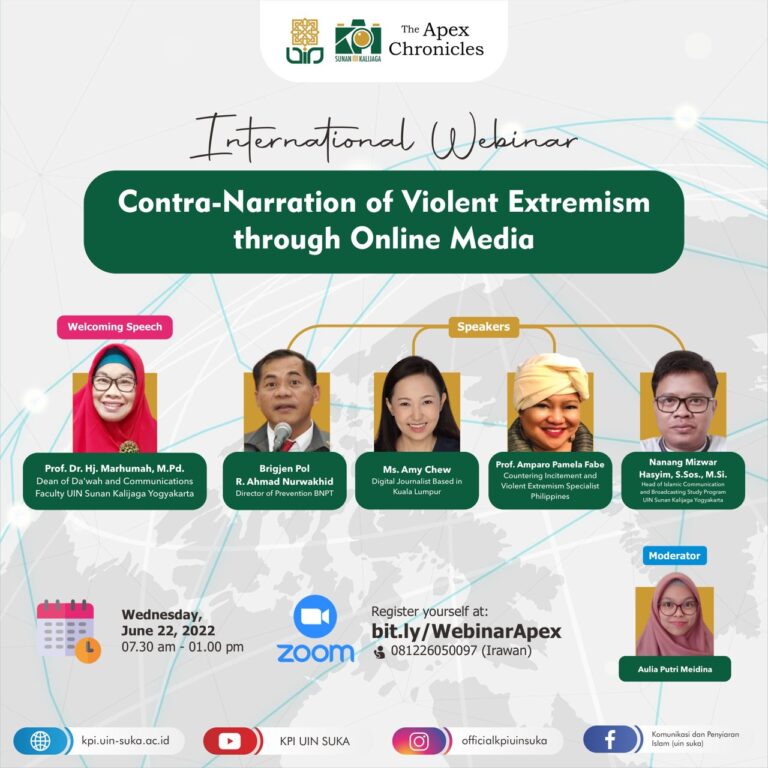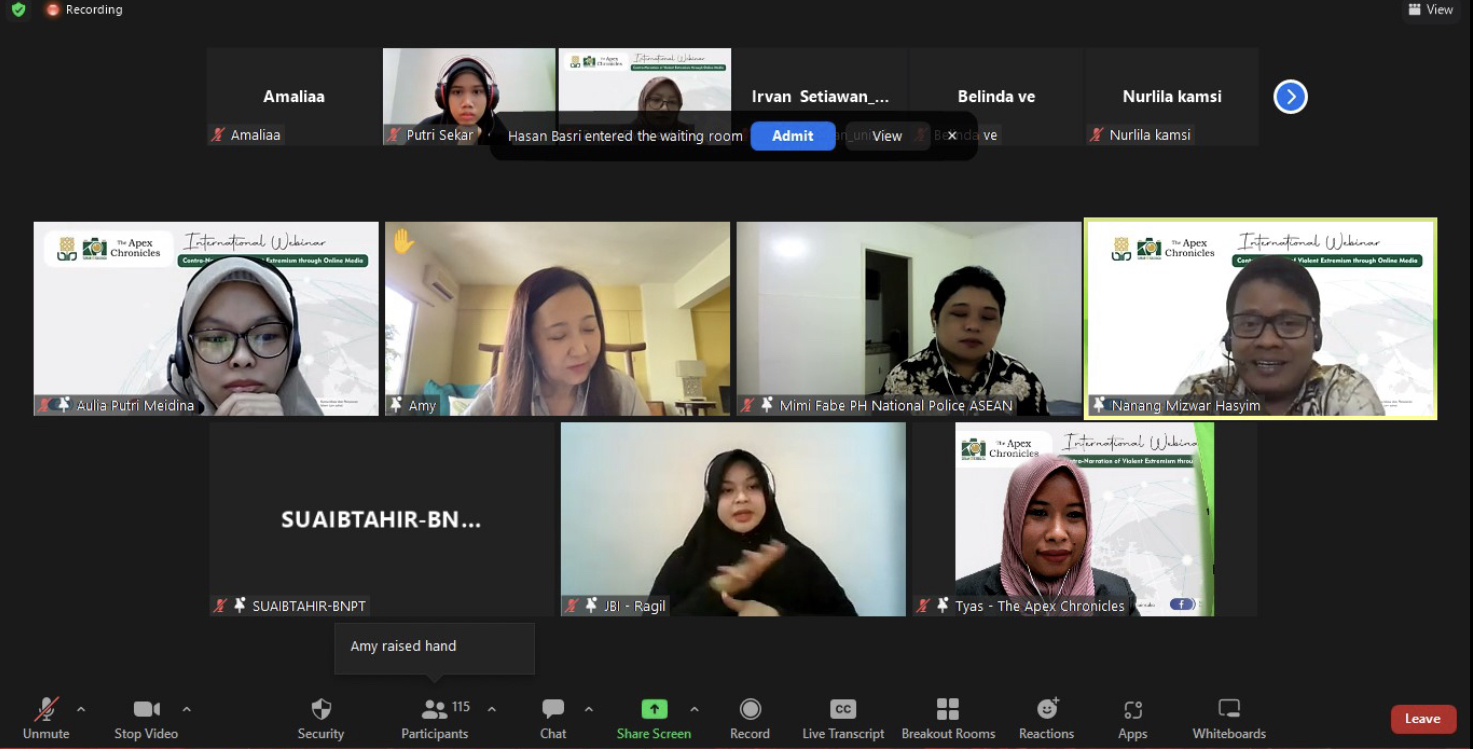Counter Narratives of Violent Extremism through Online Media

Since the emergence of ISIS in Indonesia in 2014, and in several Southeast Asian countries such as Malaysia and the Philippines, the trend of spreading radical and terrorist ideas through the internet has been increasing. This happens along with the pace of development of technology and information. Radical groups and terrorists who were previously known as closed-minded and opposed to modernity are now quite open in using modern technology to spread their influence among the wider community. The process of spreading propaganda through social media is considered an effective way to combat groups that are considered “other”. The influence of ISIS, which mostly targets young people as active users of social media in the three regions, raises its own concerns.
The growth of this new media triggers the birth of new religious authorities which are then able to replace traditional religious authorities which are usually institutionalized in ta’lim assemblies, madrasas and Islamic boarding schools. However, along with the formation of a new religious authority in cyberspace, the traditional religious authority has shifted. Social media changes not only the production and consumption processes regarding religion, but also the pattern of the spread of religious understanding. The role of interpreting, legitimizing, and spreading religious teachings, for example, no longer belongs only to religious figures, but also to all individuals who are active in social media and have the same opportunities and roles.
Social media is often used as a medium for framing, propaganda, and blaspheming between religious communities (violent extremism), thus triggering the emergence of real actions and noise. ISIS, for example, does a lot of propaganda and spreads its influence using online media and online applications such as online games and the online entertainment media TikTok. This propaganda does not only influence someone to go to Syria, but is also able to give rise to acts of terrorism in Indonesia that are carried out individually when the perpetrator does not have a direct connection with the terrorist network but is connected through online media, so that the perpetrator takes his own action, as what is normally called a lonewolf.
Data from the Ministry of Communication and Information in 2021 stated that internet users in Indonesia reached 202.6 million people or about 73.7% of the total population of Indonesia. This number is an increase of 15.5% compared to 2020, but Kominfo found 20,543 contents that are indicated to be radical, and terrorism content is also spread and found invarious social media platforms that are currently blocked. This shows that radical groups and terrorists have a position as a noisy minority, a group with a small number but a bigger echo on social media, compared to a moderate group which,although having a larger proportion, the nature of its participation in social media tends to be silent.
“Since ISIS entered Indonesia in 2014 most websites that have appeared on the internet have been dominated by radical narratives, and not many moderate narratives to compensate for the many radical narratives,” said Muhammad Suaib Tahir, special staff of the Directorate of Prevention, National Agency Counter-Terrorism (BNPT) in a Webinar entitled Contra-Narration Violent Extremism through Online Media, which is a collaboration between The Apex Chronicles and the Islamic Broadcasting and Communication Study Program, UIN Sunan Kalijaga Yogyakarta. This is what drives the government to take precautions and ensure that the mechanism for using the internet does not lead to radical acts and terrorism.

The Power of Media and Terrorism Propaganda
ISIS groups in Indonesia, especially Jamaah Ansharut Daulah (JAD) target young people and anyone who is actively using the internet and is still spiritually empty or has not been influenced by moderate ideology. They are targeted because they are considered easier to be misled and manipulated.Recruiters give them a distorted interpretation of the verses of the Qur’an to legitimize the struggle against the Syrian government as a struggle in the way of Allah or jihad.
Muhammad Suaib Tahir explained that “ISIS was able to produce 17,000 articles in various languages containing narratives of radicalism and terrorism as well as short films aimed at influencing children. From here we can see how the effectiveness of the narratives they produce is usually directed at creating a chaotic, uncomfortable atmosphere so that people do not trust the government. This is what causes no less than 2000 Indonesian citizens who decide to go to Syria and “jihad” there. In addition, there are various suicide bombing cases, such as the case of a woman who detonated a suicide bombing at the Indonesian National Police Headquarters (Mabes Polri), and the bombing case that occurred in Sumatra, which was carried out by young people as lone wolves due to exposure to propaganda narratives in the media. social,” he said.
The phenomenon of people’s influence on the narrative on social media does not just happen, recruiters start something from scratch. This group has a participant categorization on social media which is divided into 3 levels: (1) Passive support is the group of social media users who make social media a part of their lives, (2) Active support is a group that actively sends and disseminates various writings containing radical narratives. The algorithm system allows this group to identify whether someone has the potential to be exposed and become active support, and finally (3) Massive support, namely internet users who have joined radical and terrorist groups. Here their association has begun to be limited and has been able to produce radical and terror narratives. The content of the religious narratives they produce usually emphasizes three things (1) the character they instill is a kind of racism, meaning that they are God’s chosen servants/representatives who, representing God, determine hell or heaven for someone, (2) things related to simplification. religious teachings, and (3) instilling truth claims. This group usually assumes that whatever they understand and know is the truth, otherwise it is wrong. From this, 2 groups were born, the non-deviant/non-infidel group (haq community) and the heretical/infidel group (batil community).
Parental Influence and Hidden Dangers in Online Games and Online Entertainment for Young People
Online games and online entertainment are also places for extremist groups to recruit young people with passive support to become active support and even massive support. Amy Chew Digital Journalist Based in Kuala Lumpur explained that “in online games extremists look for random players, their interactions in online games are initiated as friends in an online game over and over again to earn their friendship and trust. The relationship then continues to the stage of real encounters and indoctrination, which makes online game players trust recruiters 100%,” she explained in the International Webinar.
The results of research conducted by Amy Chew on boy gamers and girl gamers found that ISIS produced videos that glorified violence and included it in video game sessions, where the narrative content conveyed in the video was not much different from the narrative that developed on social media, namely stating that the blood of the infidels is lawful, and an invitation to jihad, which helps the Muslims who are being afflicted.
In addition to online games, the entertainment media TikTok has also become a propaganda “tool” by the ISIS group. Similar to online games where propaganda is carried out through videos inserted into games, the propaganda media used by this group on TikTok also uses video. The video distributed on TikTok contains the execution process carried out by ISIS but the video is edited into short parts like a soap opera series and in each part it ends at the most important moment, right before the execution. This is so that Tik Tok users are interested in continuing to watch the show until all episodes are seen. Usually at the end of the episode there is a link to go to the full execution video.
The phenomenon of the openness of young people to join radical and terrorist groups is not only influenced by social media, online games and online entertainment. Based on the results of her research, Amy Chew also found that parents, and middle-aged people who are around young people, are also a big threat, because if parents have been indoctrinated with radical ideas, parents will tend to spread these messages to their children and grandchildren. This can be seen in the Surabaya Bombing case in 2018 where a father named Dita Oeprianto turned his entire family into a suicide “team”. Hisfour children became helpless victims of his radical views. His four children died as suicide bombers, including Dita’s eldest child, Yusuf Fadhil.
Amy Chew asserts that “parents are considered more dangerous in influencing children and their families because nothing can stop the process of parental indoctrination towards children. Parents tend to be trapped in their own thought patterns, which they think are correct. Efforts to reason with parents will only lead to anger, so the only thing that can be done is to limit the impact of the damage,” concluded Amy.
Counter Narrative by Philippine Law Enforcers
In addition to Indonesia and Malaysia, the Philippines is also one of the countries in Southeast Asia that is a breeding ground for radical and terrorist movements such as ISIS. Similar to Indonesia and Malaysia, in the Philippines the phenomenon of violence and extremism is a problem that continues to involve young people. In this case Prof. Amparo Pamela Fabe as Countering Incitement and Violent Extremism Specialist Philippines explained that “in the Philippines several efforts have been made by law enforcement in the context of anti-terrorism actions both offline and online, offline such as (1) forming an anti-terrorism council, (2) prevention programs and the fight against terrorism, (3) the program to prevent and limit terrorism, and (4) the international capacity building program. Apart from that, Amparo Pamela also added that law enforcement will give 12 years in prison to anyone who threatens to commit acts of terrorism,” she explained in the International Webinar entitled Contra-Narration Violent Extremism through Online Media.
In addition to this, Filipino Muslims receive various assistance in the form of funds and skills training. Prof. Amparo said the government gave 73 billion Pesos to the Muslim autonomous region of Mindanao Bansamoro, provided jobs for the Muslim community, agricultural support assistance, and livelihood and skills training.
Meanwhile, anti-terrorism measures are also carried out through social media. The Philippine government maximizes the function of social media such as Facebook, Facebook Messenger, Telegram, and TikTok as “tools” to spread counter-narratives. Through the International Criminal Investigative Training Assistance Program (ICITAP) in collaboration with foreign governments, the Philippine government seeks to build professional and transparent law enforcement agencies that protect human rights, eradicate corruption and reduce crime, where the US-sponsored ICITAP trainings are devoted to the police and focused on creating and disseminating narrative content about unity in diversity and family values.
At the end of her presentation Prof. Amparo pointed out that thanks to these efforts the Filipino people can accept counter narratives both online and offline, every citizen is able to respect human rights, trust in the police agency increases and creates a strong dependence on law enforcement to resolve conflicts and violence.
Terrorism Discourse in Media Coverage in Indonesia
Nanang Mizwar Hasyim, M.Si, on the occasion emphasized that the mass media is considered to have an influence on people’s perceptions of the reality of terrorism. According to him, the discussion of terrorism in Indonesia is an endless topic and seems to be a routine and mandatory headline for the Indonesian media, especially television, which tells a lot about the actors of acts of terrorism.
“Indonesian mainstream media places more emphasis on the point of view of the involvement of acts of terrorism with radical Islamic networks in the world, such as ISIS, Al-Qaeda, and others. In addition, many Indonesian mass media explore the reality of acts of terrorism by focusing on biographical descriptions and profiles of terrorist acts. When viewed from the perspective of the mass media, the impact of the Bali bombings and other acts of terrorism has become the embryo of globalization which tends to lead to a homogenization process. namely a process of mobilizing information products that leads to a conclusion that the perpetrators of terrorism are part of a radical movement originating from one of the schools of understanding of Islam,” concluded Nanang Mizwar.
This International Webinar event was closed with a message from Muhammad Suaib Tahir that radicalism and terrorism are the enemy of all of us. We must put all our energy into eliminating and preventing this virus, because radicalism and terrorism are a virus, so to eliminate them we must create another “virus”.



